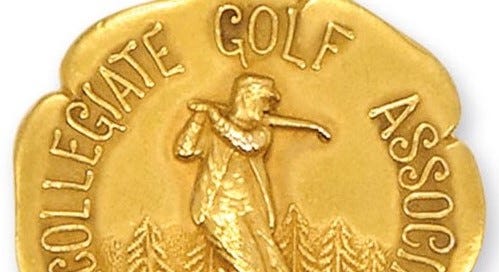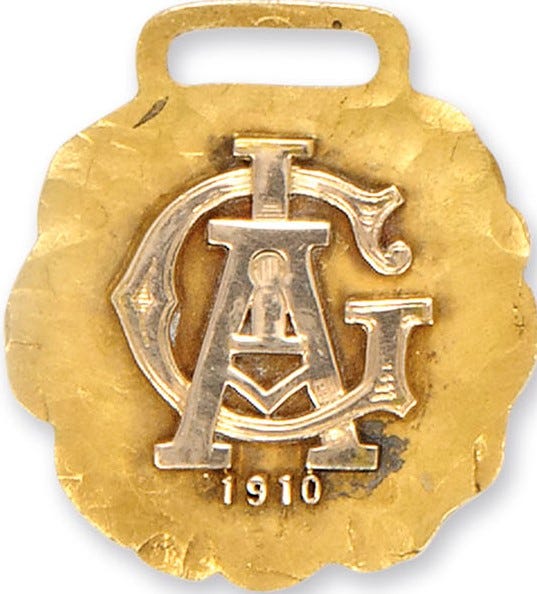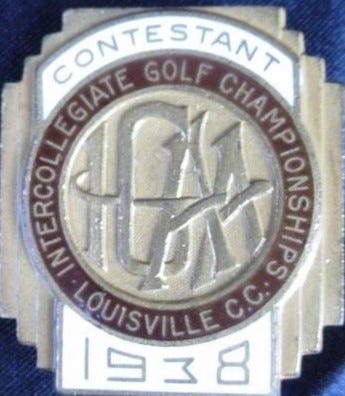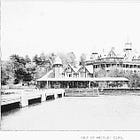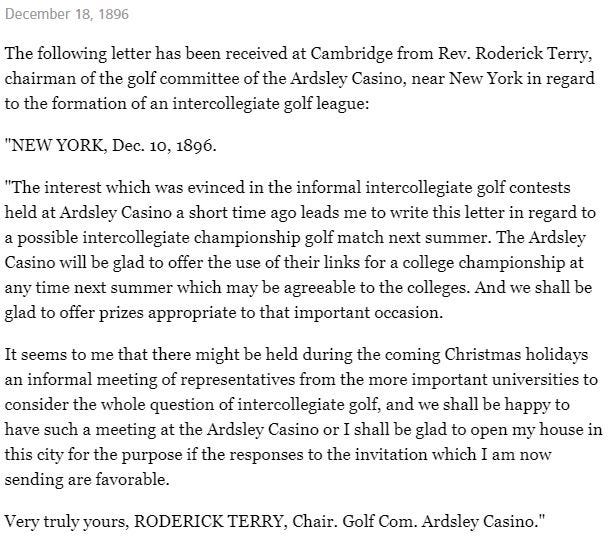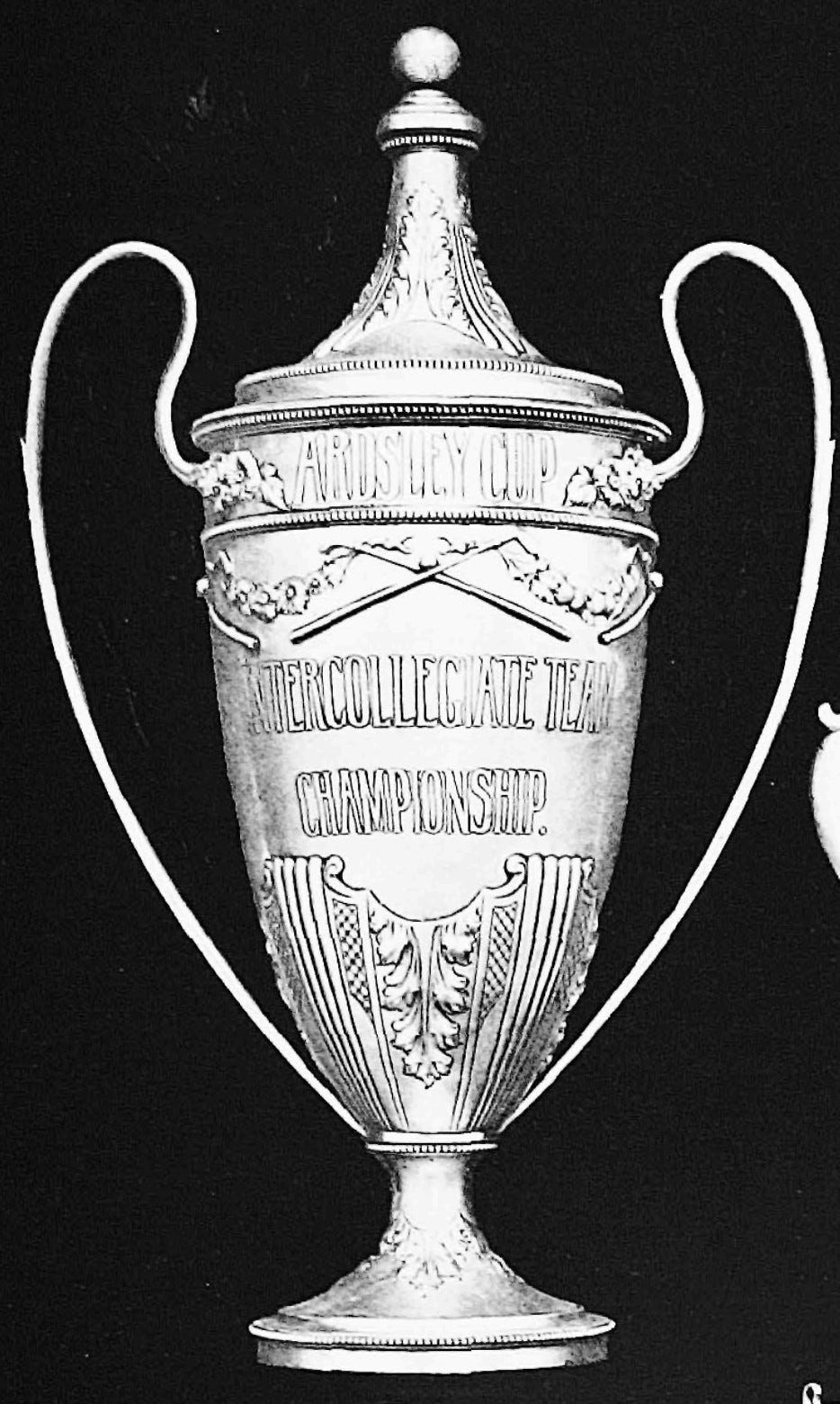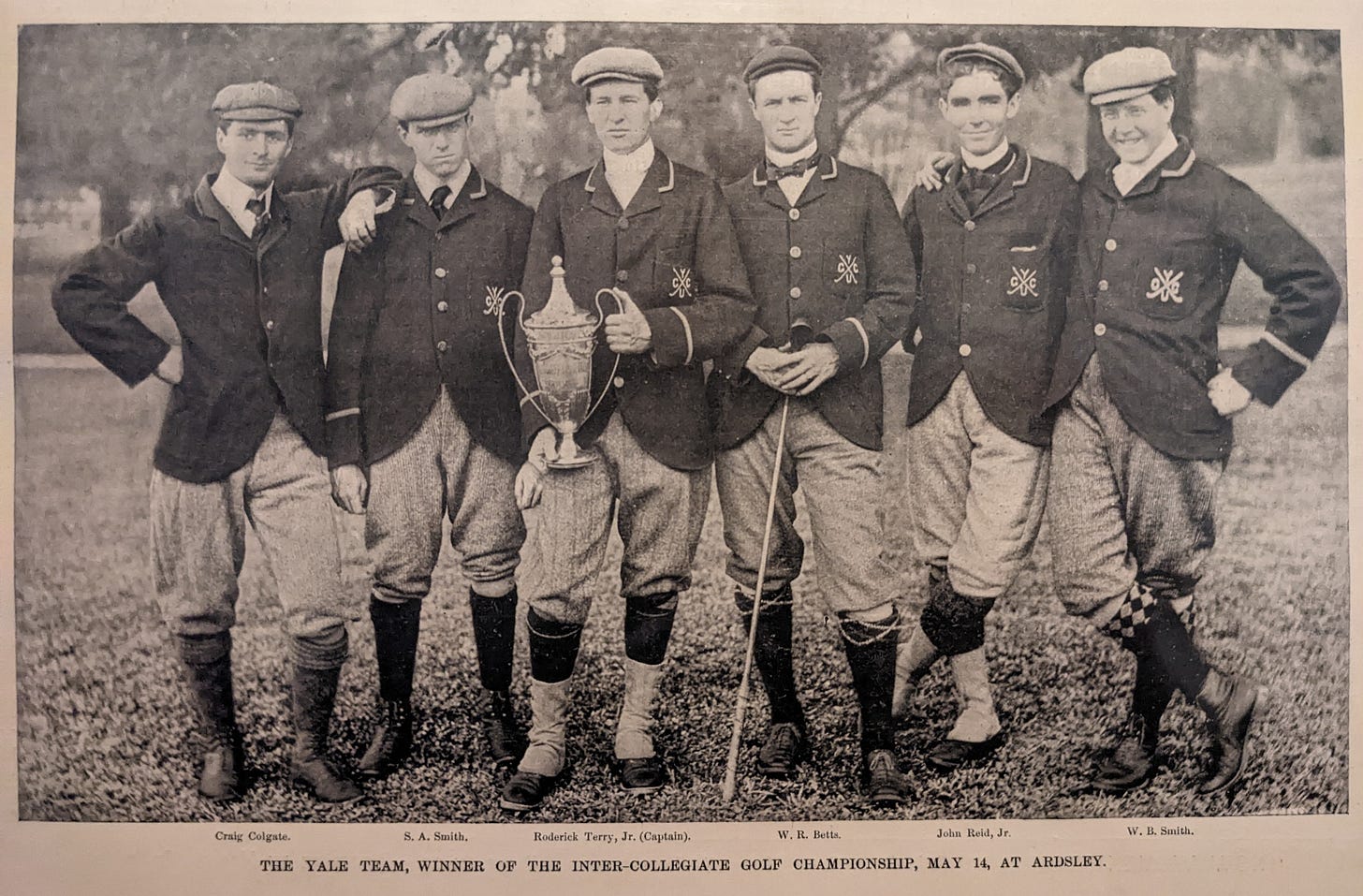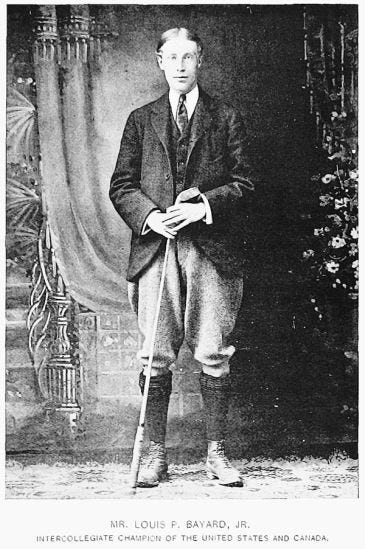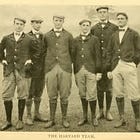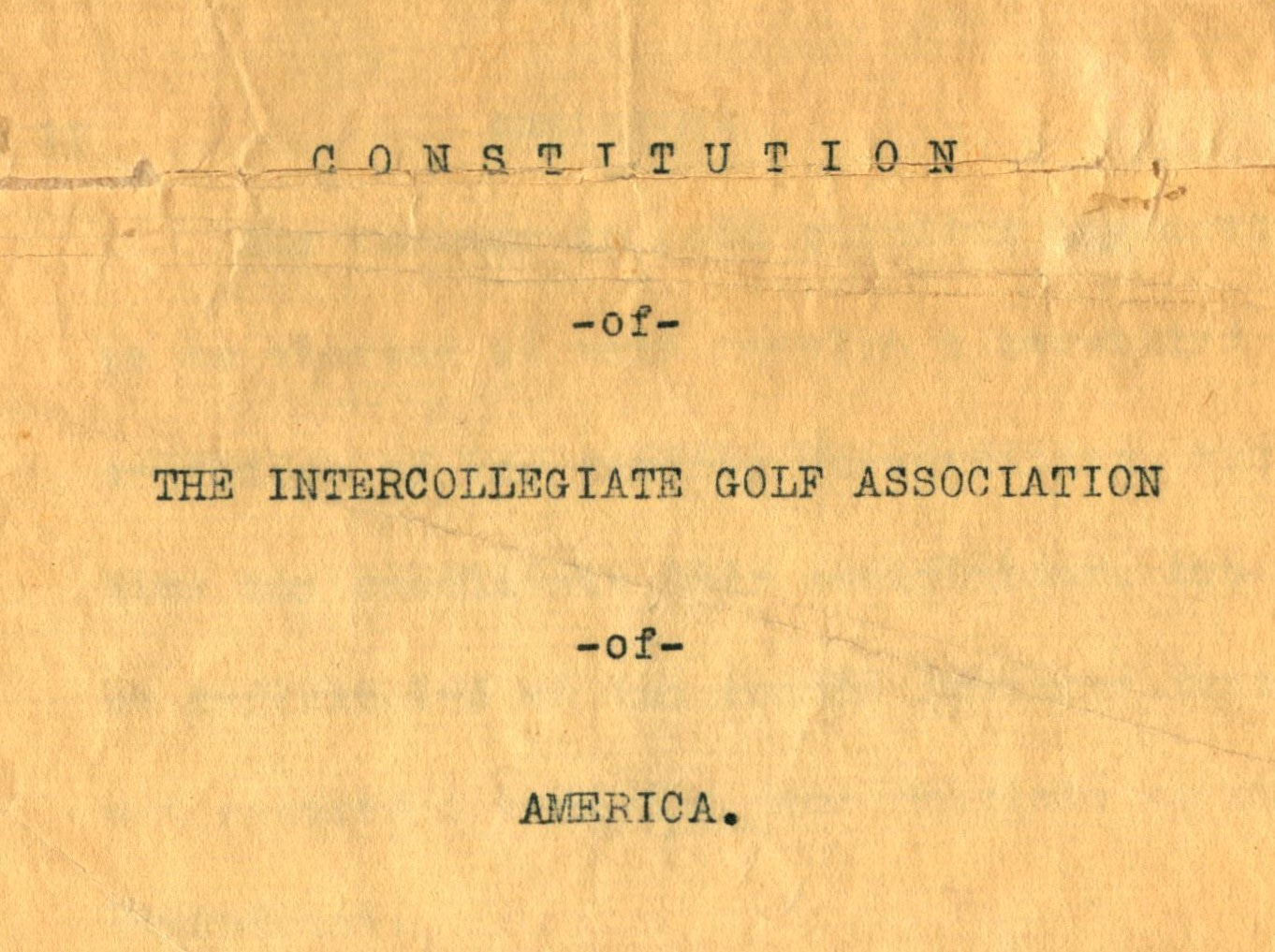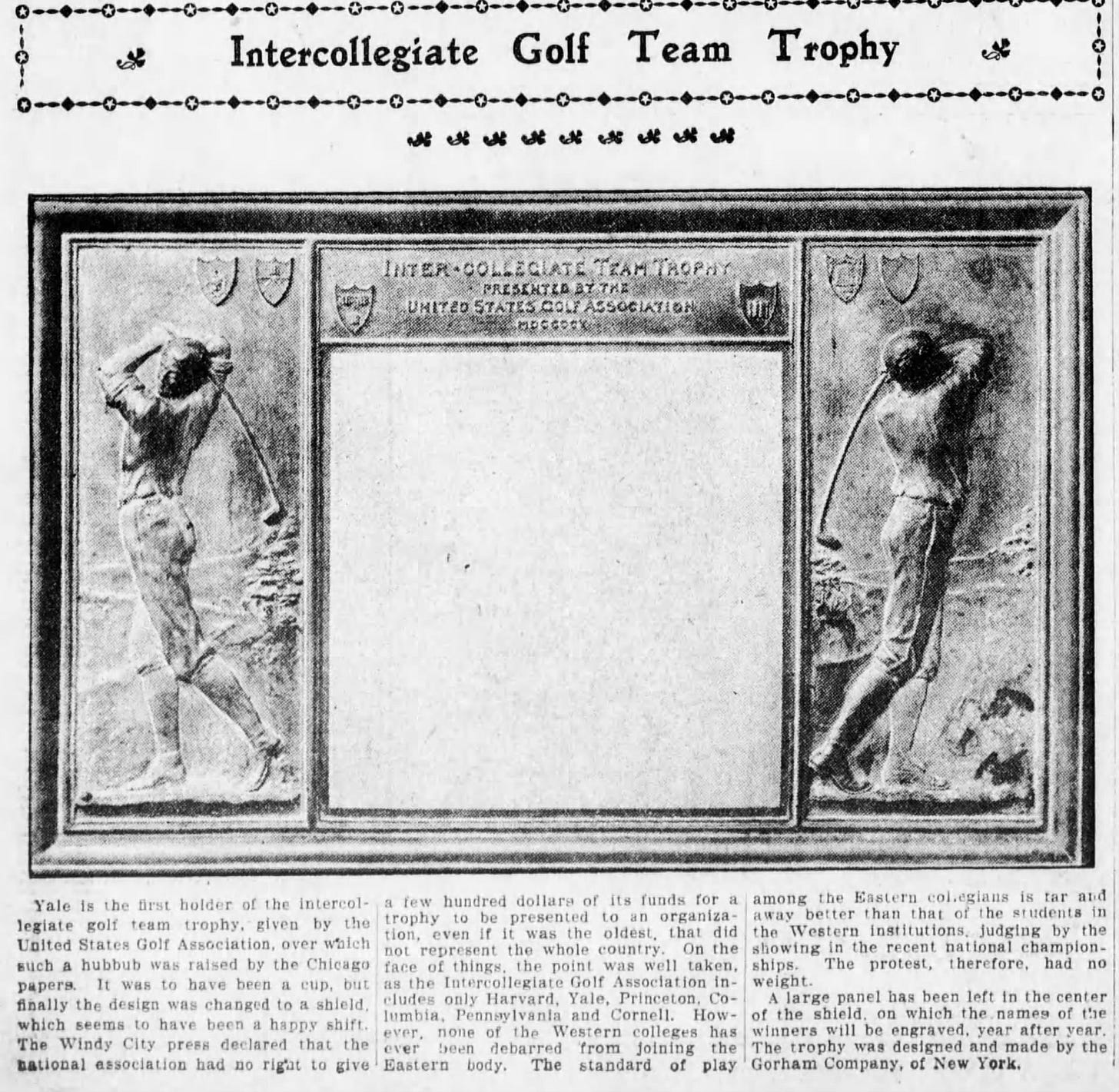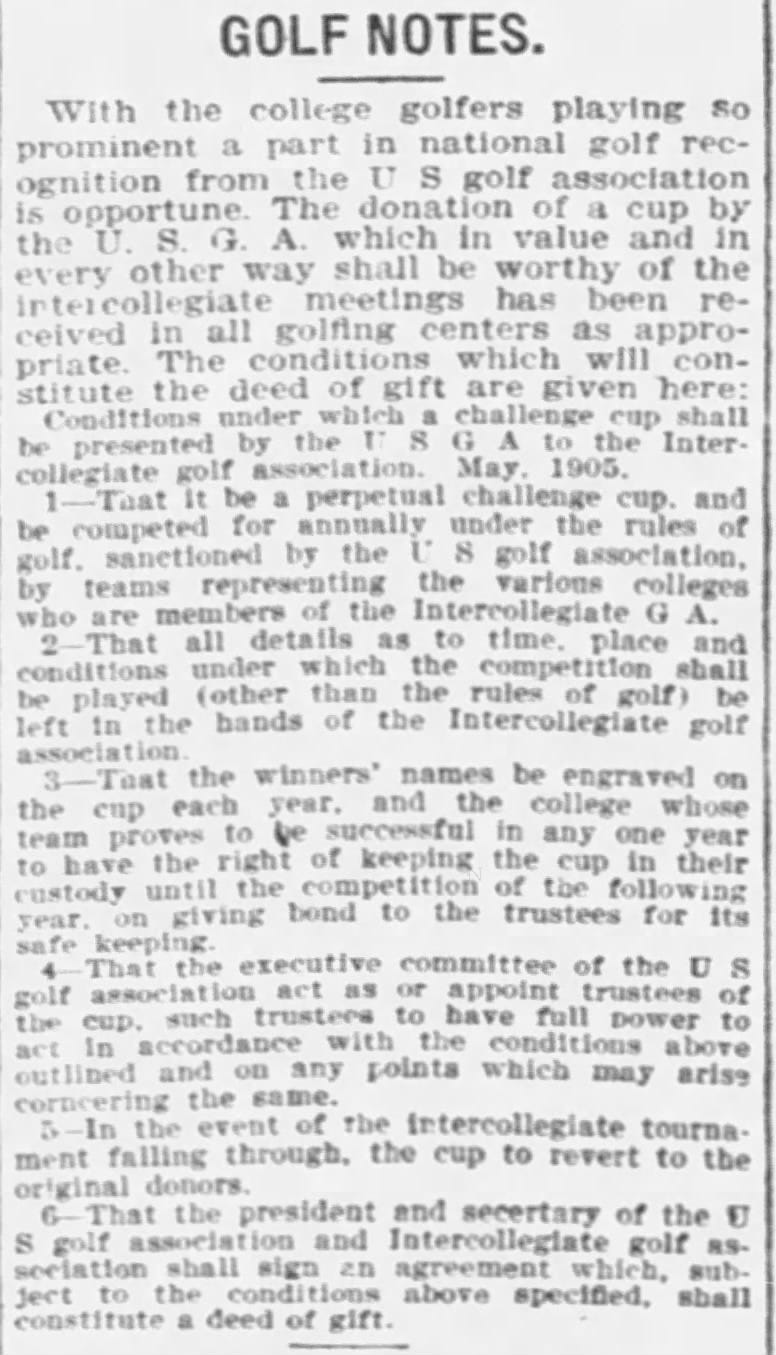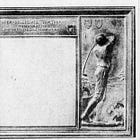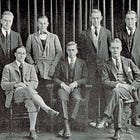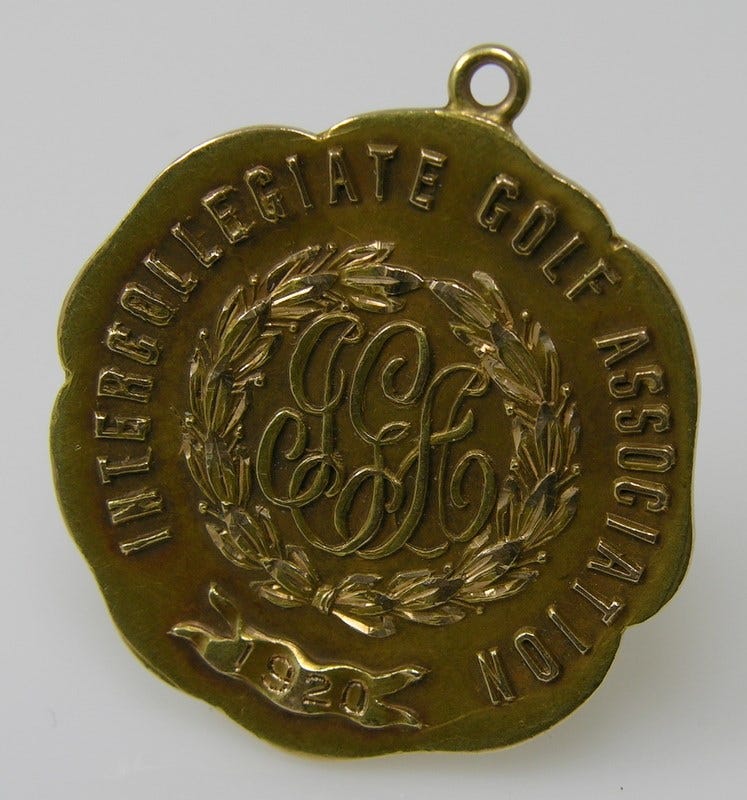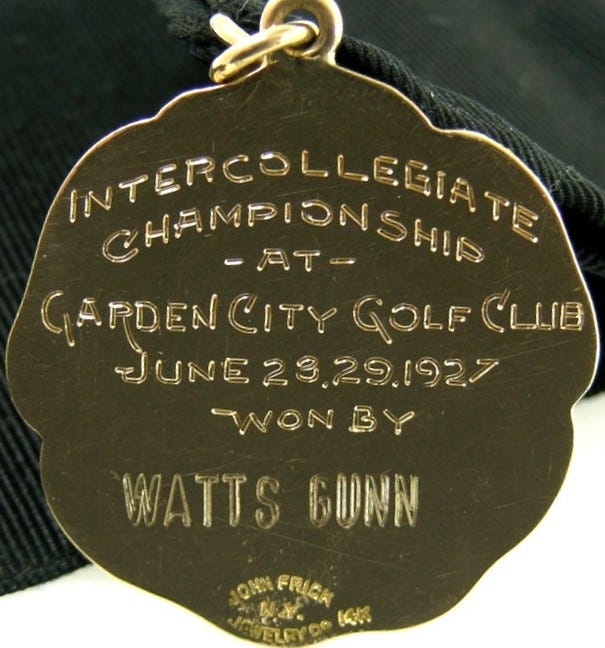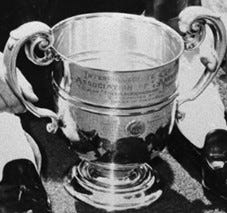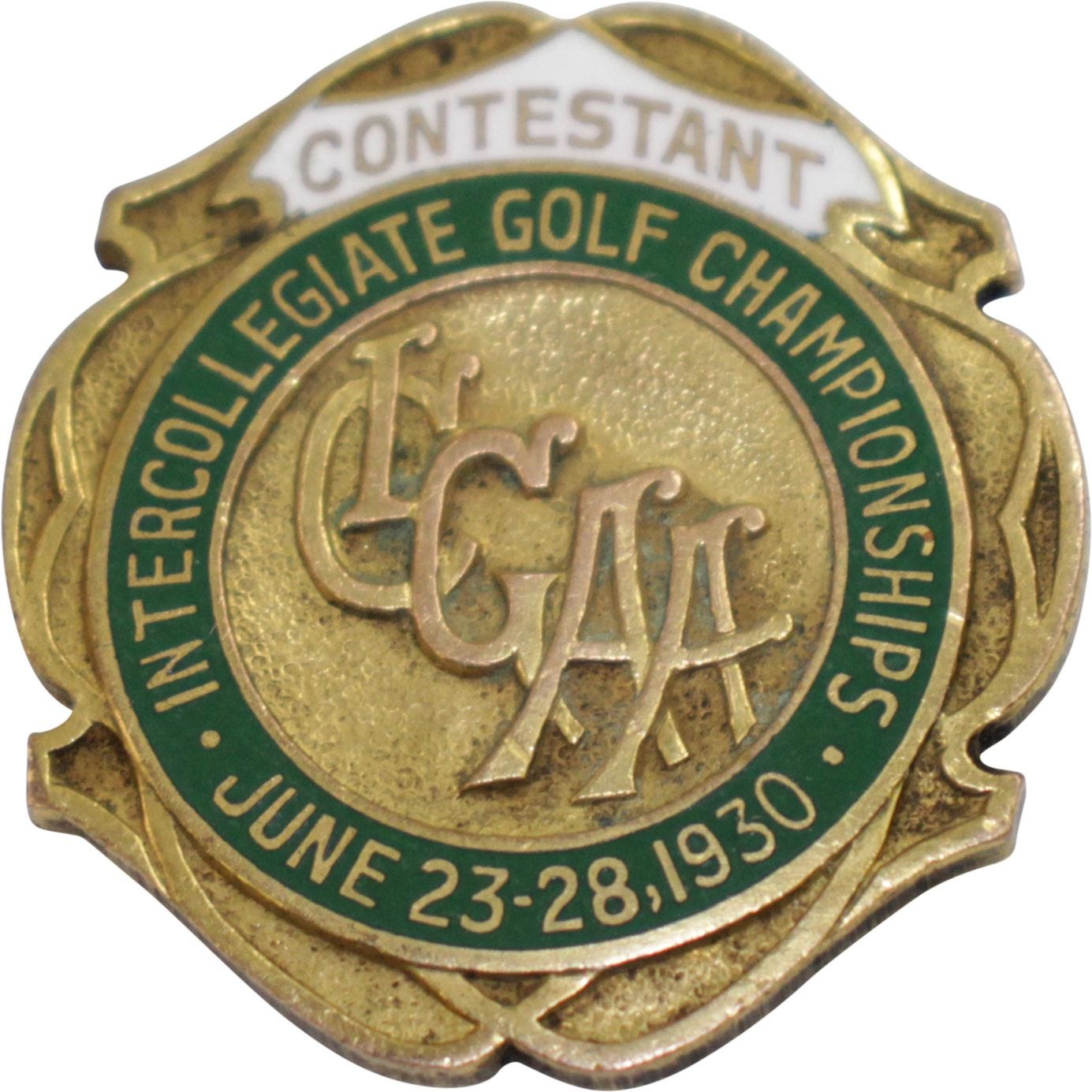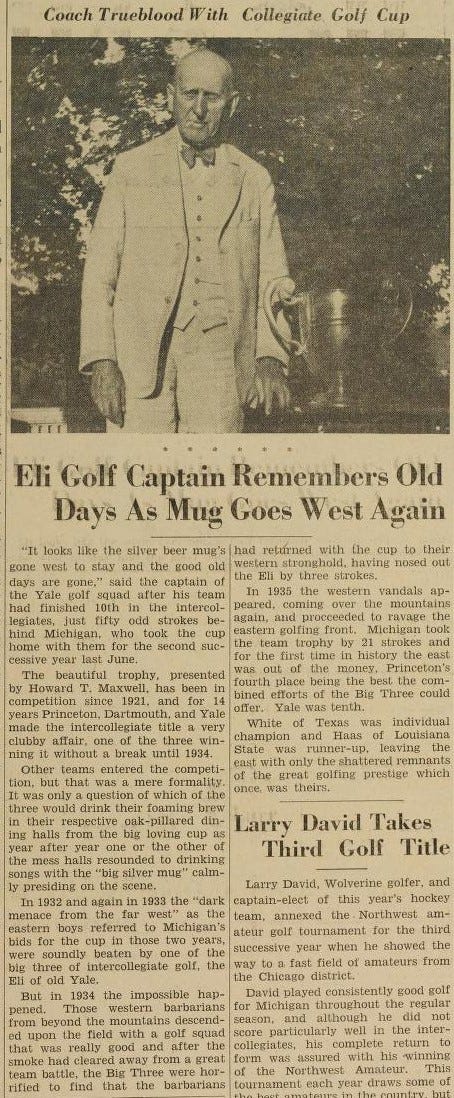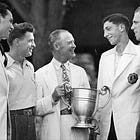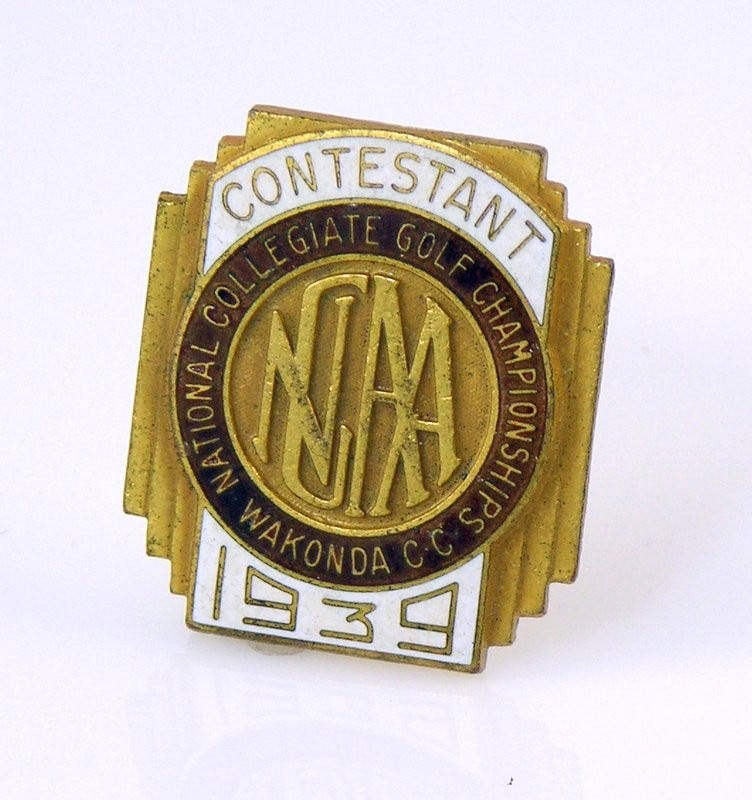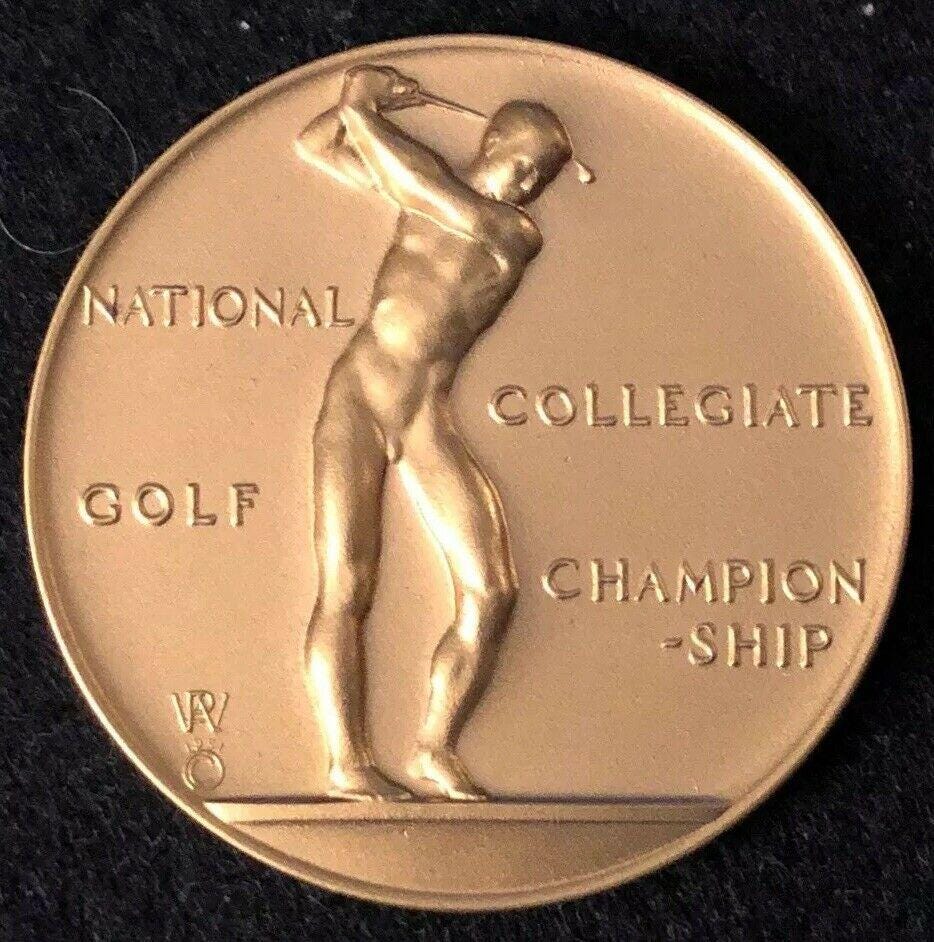THE INTERCOLLEGIATE GOLF ASSOCIATION: COLLEGE GOLF’S FIRST RULING BODY
The Intercollegiate Golf Association (IGA) - sometimes broken into “Inter-Collegiate” and other times with “of America” appended to the name - was an organization comprised of collegiate players directly involved in running the annual championship from 1897 until sometime during World War II. Today we will explore some of the organization’s history from beginning to (likely?) end.
Note: Since we touched on the IGA throughout our Men’s Championship series, there are embedded links to specific entries throughout this post. Also, underlined text is a link to a reference material and/or more details.
IN THE BEGINNING…[1896]
Our first post in the Men’s Championship series gives a more expansive background on the state of golf in the mid-1890s. The main takeaway is that the formation of the USGA was important not only for the game of golf overall but also specifically for college golf as the children of several prominent figures at these golf clubs (as well as the other ~25 clubs that had joined by 1896) were attending or otherwise had close ties to prominent universities such as Yale, Harvard, Princeton, Columbia, and the University of Pennsylvania (“Penn”). It was at these universities, with students who had the connections and money to pursue the game, where the idea of golf as a collegiate sport took root.
In late 1896, (Reverend) Dr. Roderick Terry, chairman of the golf committee at Ardsley Casino (Golf Club) - located on the banks of the Hudson River in NY - and father of Yale University Golf Club captain, sent out invitations to the five universities mentioned above to play a series of matches. Only two of the schools, Yale and Columbia, were able to attend that first intercollegiate match, yet it went well enough that everyone became excited for creating an actual championship. In order for that to happen, they needed to formalize a governing body. Once again it was Dr. Terry spearheading the effort when he sent the following letter to the universities in December:
All five universities sent representatives to the first meeting of what became known as the Intercollegiate Golf Association. The goal was to institute an official committee capable of organizing future events, run by the players themselves as representatives for their respective university. This concept of a student-run governing body wasn't as strange at the time considering it was the students/players themselves that ran the teams, and it plays an important role in understanding the future development of the sport.
THE FIRST CHAMPIONSHIP [1897]
Five short months after the creation of the IGA, four of the universities sent 6-man teams to Ardsley to compete for the first Intercollegiate Golf Championship.
Ardsley Casino club served as host again at the behest of golf chairman Roderick Terry Sr. In order to ensure stability to the tournament in its early years, the club made an agreement with the IGA to host the event for the first three playings, and made a big show of going all out to provide nice amenities including stunning awards (see below).
The next two championships, both in 1898, were held at Ardsley as stipulated by the original agreement with Dr. Terry. At the second annual IGA meeting in the early part of 1898, the officers decided that the championship was better suited for the Fall. Waiting ~18 months for the next event seemed like a terrible option, especially for those players set to graduate in May 1899, so instead they decided to double up championships in the current year.
With Yale winning the first two championships, it only needed to win the Fall 1898 championship in order to gain permanent possession of the Ardsley Cup. Instead, Harvard pulled out a dramatic tie-breaker victory which meant the trophy, like the championship itself, would travel to a brand new course the following year.
AFTER ARDSLEY [starting 1899]
After their partnership with Ardsley had ended, the IGA’s main responsibility each year - beyond electing new officers for the role of President, Secretary, and Treasurer - was to secure a site for the next championship. The first of these sites was a new course in Garden City, NY that was quickly becoming one of the most talked about courses in the country.
The December, 1899 IGA meeting resulted in several unexpected changes. One was the announcement of a new scoring system, their first of many experiments in finding the “best” format for determining a worthy team and individual champion. The decision to move back to the Spring season wouldn’t have been such a drastic announcement if it hadn’t been for the additional announcement that there would be no tournament in 1900. Several newspapers captured the confusion and derision many felt about this decision, all to no avail.
Although there was no tournament to plan in 1900, the IGA used the time to create a new formal constitution. This document, now housed in the USGA archives, formalized many things including the tournament format, admitting new university teams to the organization, and the process by which changes could be made in the future. Handwritten notes on several pages combined with various newspaper articles over the next several years shows how this document was used and amended as it was passed around the universities with each new election.
FIRST USGA CONNECTION [1905-06]
One of the first major crises the IGA faced involved the purchase of a new trophy. With their victory in 1901, Harvard had officially won the Ardsley Cup three times and thus it took up permanent residence in their trophy collection. This meant that the IGA was going to have to replace it with another trophy. When no other golf clubs stepped forward to match the generous gifts that Ardsley had provided, the college players were forced to make a decision on their own. The result of this was interesting in two respects:
Each of the universities were charged $100 towards the purchase of a new trophy. The details on the collection of this money is a little hazy, but apparently it didn’t go over too well and this, combined with the cost of the new prize coming out to be higher than expected (~$600) meant that the IGA was in debt for a couple of years, which ramped up tension
The rules around possession of the trophy was apparently not made crystal clear. When Harvard won their third in a row again in the Fall of 1904 - the championship switched seasons again in 1902 and again the decision was to double up championships that year - there was an immediate outcry as the Crimsons thought the trophy was theirs to keep while others argued that with the money coming out of their own pocket (and still in debt) the trophy was to be a persistent traveling trophy which couldn’t be won outright
It would seem that the infighting got bad enough that the USGA - which had numerous personal and “professional” ties to the IGA (let’s call it a big brother rather than parental relationship at this point) - would step in and offer a lifeline in the form of a donated “trophy” (more of a shield) with interesting conditions.
With the USGA’s gift resolving the long-term dispute, the conditions for keeping the existing IGA trophy was finally re-negotiated in 1906. Yale’s win that year counted as the first and their victories the next two years meant that the 1908 Yale team satisfied the 3-win condition to take ownership of the IGA trophy.
INCREASING MEMBERSHIP [1908-15]
While the IGA and its championship was originally said to be open to all colleges in the United States (and Canada), it wasn’t until 1903 that membership expanded beyond the original five universities. That same year, another similar organization called the New England Intercollegiate Golf Association (NEIGA) began hosting its own championship that included Amherst, Bowdoin, Brown, MIT, Williams, and Dartmouth. The NEIGA tournament ran annually until 1907 when it was dissolved and two of its members joined the IGA which now had 8 member teams: the five original, Cornell (joined in 1903 but only team appearance so far in 1906), Williams, and Dartmouth. Interesting side note: Syracuse had actually made a petition to join the association as well in 1907 but was dropped without ever participating.
After a Northwestern student and golf prodigy known throughout the country as “Chick” Evans was prevented from competing in the 1910 IGA championship due to the fact his team was not a member of the organization, several of the “Western” schools in the Ohio-Illinois-Iowa-Michigan-Wisconsin area began discussing the formation of a Western IGA (WIGA). Although all of these schools were members of the well-established “Inter-Collegiate Conference” which was known informally as the “Big Ten”, golf was not yet considered a sport worth sponsoring an actual championship; hence the need for the WIGA. Passion for this new organization faded when Evans left school in early 1911, but would eventually become a reality a few years later. It wouldn’t be until 1915 that one of these Western teams, Illinois, was finally accepted into the (“Eastern”) IGA.
THE EFFECTS OF WORLD WAR I [1916-18]
The 1916 IGA championship was a major turning point for the organization as it was the first time held “out West” in the hopes of attracting more Western teams. The legendary Oakmont course proved to be every bit the perfect stage for a dramatic championship that included Illinois bringing a full team and other schools such as Northwestern being represented by one or two players vying for the individual championship.
Just as college golf seemed to be on the verge of greatly expanding, the United States entered the global conflict known today as World War I. The IGA had planned out the 1917 championship to be held at Merion in September, but when the time came, tournament officials at the club found that practically all of the potential players and IGA officers had already been drafted into the war effort. Thus there was no championship held in 1917 or 1918.
POST-WWI [1919 thru 1920s]
Thanks to the efforts of Columbia’s A.L. Walker - eventual champion - college golf was started back in earnest in 1919. The return from WWI brought an opportunity to make many changes including switching seasons back to the Spring/Summer, dropping team match play in favor of medal (stroke) play, and increasing the number of individual match play slots. It wasn’t just the tournament itself that changed, the IGA also gained representation in the USGA in 1921 so that the IGA President would double as the committee member on Intercollegiate Affairs, an important step in formalizing the relationship between the organizations and a move that would eventually lead to the USGA taking over responsibility of the tournament.
Much like the country itself, college golf enjoyed a huge boom throughout the 1920s. Amateur stars known throughout the country (and even beyond) including Bobby Jones, Jess Sweetser, Watts Gunn, and many others had meaningful ties to collegiate golf. In response, the IGA would also grow to eventually include not only the Big Ten teams, but had also allowed participation from individuals representing (true) Western teams such as Washington and Stanford, as well as Southern schools such as Tulane, Alabama, and Georgia Tech. Many of the prizes offered were finally standardized including the medals and a brand new team trophy.
USGA TAKES OVER [starting 1930]
In 1930, the USGA officially took over as the governing body responsible for the collegiate championship, although the student-led IGA would remain in place as the organization financially responsible for purchasing trophies/awards and governing membership. Functionally, things seemed to run the same as they did before, however the USGA opened many doors and provided a stable backing for the IGA which by its nature experienced turnover every year as players graduated. Starting in 1930, it was the USGA who made the official announcement on when and where the tournament was hosted, ensuring it would not conflict with other major amateur events such as its own US Amateur.
One of the interesting changes that falling under the jurisdiction of the USGA brought to the collegiate championship was the use of contestant badges that matched the exact same design and style as those worn during the USGA-run events such as the US Amateur. Note the “ICGAA” - which stands for Inter-Collegiate Golf Association of America - where the other badges have “USGA”. These badges were used throughout the 1930s, and even carried forward (for a short time at least) when the NCAA took over in the 1940s.
BECOMING TRULY NATIONAL [1934-35]
One could argue that a Southerner from Tulane winning the individual championship not once but twice in 1925-26 set the stage for the IGA championship being considered a “national” tournament. Over the next decade, players from schools such as Georgia Tech, Georgetown, Michigan, Oklahoma, and Texas, added their names to the list of individual champions from the “traditional” Eastern schools of Princeton, Harvard, Yale, and Columbia.
The 1934 championship held in Cleveland, OH marks the point when many consider the championship a truly national affair. That year a historically good Michigan team, coached by the legendary Dr. Trueblood, earned the first team championship won by a school other than Yale, Harvard, Princeton, or Dartmouth. Proving it wasn’t a fluke, the same team returned the next year to Congressional (in Bethesda, MD) and took the team title a second time. Although they weren’t able to complete the three-peat in 1936, star Michigan player Charles “Chuck” Kocsis - who had been instrumental in their success the past two years - became the second Wolverine to win the individual title. As far as nicknames go, “the dark menace from the far west” has to be one of the better ones in the history of college golf.
NCAA & WWII: THE FINAL ERA? [1939-43/44/45]
The National Collegiate Athletic Association (NCAA) was founded in 1906 but started hosting championships in the early 1920s. The NCAA considered putting on a golf championship as early as 1935 when Dean Frank Nicholson [Wesleyan, NCAA secretary-treasurer] had suggested that the NCAA add golf to its growing list of supported sports. By early 1939, the IGA had agreed with the USGA that the NCAA taking over sponsorship of the championship would be acceptable, and so a formal NCAA golf championship committee was formed that included a rotating seat for the current IGA President, similar to the arrangement previously made with the USGA. Though they might not have known it, this was the beginning of the end for the student organization.
Things went very well for the first several championships under the NCAA, but it was evident that the IGA was nothing more than a ceremonial organization as the NCAA had taken over all of the important aspects of both the championship itself as well as the membership for who could compete. By this point, universities were limited not by membership restrictions, but rather their own willingness to spend the money for travel and competition. The stability of the NCAA proved to be a great thing for college golf as the tournament was able to continue through WWII - although getting down to as low as 5 teams in 1944-45 - in a way that IGA had not been able to during WWI. Even the USGA tournaments suffered interruptions during this time, and yet the NCAA golf tournament persisted.
As of this writing, the actual ending of the IGA is unknown as there was no official announcement that this author has been able to find. It seems that the IGA was disbanded during WWII much the same way that it was during WWI; that is to say that everyone sort of left and there was nobody to pick up the mantle. There is even uncertainty with who was the true last IGA President. Michigan’s Ben Smith was elected to the position for the 1942-43 season and went on to have a very successful year in golf before leaving for the US Navy.
Although no definitive mention of the IGA has been found after the 1943 championship, there was an odd report from 1944 which named Ohio State’s Preston Crabill as the “President of the NCAA” for 1944-45, and that he would be assisted by Louis Lick, the 1944 individual champion from Minnesota. Assuming that they meant Crabill was the IGA President, not NCAA, this would mean that he was likely the final one to hold that position. With the NCAA championship down to five teams during both the 1944 and 1945 tournaments - Notre Dame, Ohio State, Minnesota, Michigan, and Michigan State/Northwestern - it would make sense that any IGA officer positions would be filled by players from those schools. Given these circumstances and the IGA’s diminished role, it is understandable how this once proud and distinguished organization could just...fade away.

